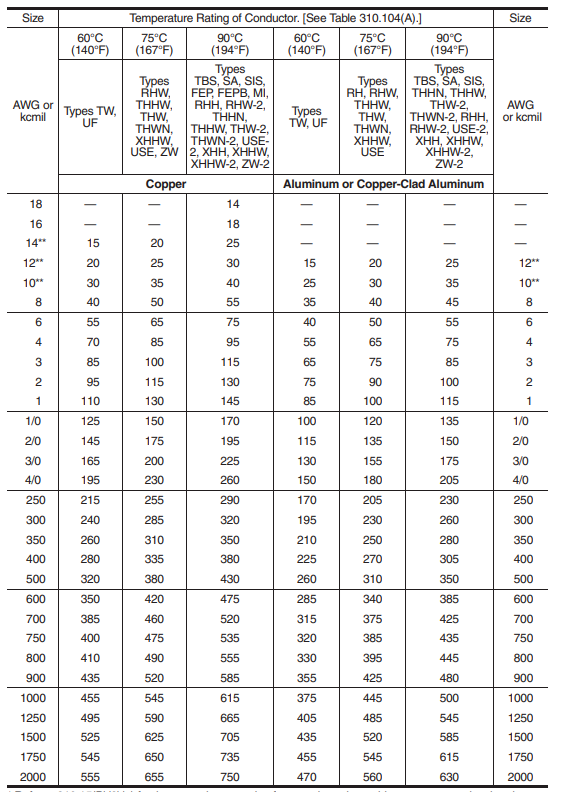Why Are Ampacity Charts Important?
Introduction: The Foundation of Safe Electrical Practice
For a professional electrician, a wire ampacity chart is not just a reference document—it’s a critical tool for safety. While the NFPA 70 (National Electrical Code) provides the rules for safe electrical installations, it is the electrician’s responsibility to apply those rules correctly. The core of this responsibility lies in understanding and utilizing an ampacity chart to ensure every conductor is appropriately sized for its intended load. Improper sizing can lead to overheating, insulation failure, and fire, making the correct use of this chart the first line of defense in protecting lives and property.
What is an Ampacity Chart? An Accessible Definition
An ampacity chart provides an accessible definition of a conductor’s current-carrying capacity. In simple terms, it’s a table that specifies the maximum current (in amperes) that an insulated conductor or cable can safely carry without exceeding its temperature rating. The term “ampacity” is a portmanteau of “ampere capacity.” This value is not a fixed number and is influenced by several factors, including the conductor’s material (copper vs. aluminum), insulation type, ambient temperature, and the number of other current-carrying conductors grouped together in a raceway or cable.
Chart here is adapted from the National Electrical Code (NEC) as published by the National Fire Protection Association (https://www.nfpa.org/).

The Dangers of Under-Sizing and How to Avoid Them
Under-sizing a conductor for a specific load is one of the most common causes of electrical hazards. When a conductor carries more current than it is rated for, it overheats. This can cause the wire’s insulation to melt or become brittle, leading to short circuits, ground faults, or fires. A properly selected conductor, based on its wire ampacity chart rating, ensures that the wire’s temperature remains within safe operating limits, even under a continuous maximum load. For example, when running a circuit for a standard receptacle on a 15-amp circuit (typically using 14 AWG copper wire), the continuous load must not exceed 12 amps (80% of the circuit rating, per NEC 210.19(A)(1) for continuous loads, defined as maximum current for 3 hours or more). For a 15-amp continuous load, a 20-amp circuit with 12 AWG copper wire (rated for 20 amps) is required to handle 125% of the load (18.75 amps), ensuring safety and code compliance.
How to Use Wire Ampacity Charts for Safe Electrical Installations
To ensure NEC-compliant electrical safety, electricians must master the use of wire ampacity charts for every project. These charts guide the selection of the correct conductor size to prevent overheating and comply with NFPA 70 standards. By factoring in load requirements, ambient conditions, and continuous load derating, electricians can confidently design circuits that protect both equipment and occupants, making ampacity charts an essential tool for professional, hazard-free installations.
Practical Application: Selecting the Right Conductor
The practical application of an ampacity chart is a fundamental skill for every electrician. The process involves a few key steps:
- Identify the Load: Determine the total amperage of the circuit you are designing or working on, noting whether it is a continuous load (3 hours or more) requiring a 125% sizing factor.
- Consult the Chart: Use the ampacity chart to find the minimum wire size that can safely handle the load. Be sure to account for all relevant factors like the number of conductors, ambient temperature, and continuous load derating.
- Cross-Reference with the Breaker: Ensure the chosen conductor size is appropriate for the circuit breaker’s rating to provide overcurrent protection.
This methodical approach applies to all installation tasks. For instance, while installing ground fault circuit interrupter outlets is a crucial safety measure for shock prevention, it doesn’t protect against the risk of fire from an undersized wire. Similarly, properly tying cables in a neat and organized fashion within a box prevents pinching and damage, which can also lead to hazardous conditions.
Compliance & Safety Protocols
Correct wire sizing is not just a best practice; it is a core requirement of NFPA 70, the National Electrical Code. It’s also an integral part of the safety-focused work practices outlined in NFPA 70E. This standard governs how professionals safely work on or near electrical systems, emphasizing that every aspect of the job, including wire selection, contributes to the overall safety of personnel and property. When working on an energized circuit, an electrician must understand that the proper design and installation of the circuit—guided by the wire ampacity chart—is a prerequisite for safety. Additionally, the presence of a protective surge device on a circuit can protect sensitive equipment from transient voltages, but this feature in no way negates the need for a correctly sized conductor.
Conclusion: Beyond the Code
The ampacity chart is a powerful tool that serves as a constant reminder of the unseen dangers of electricity. For a licensed electrician, the ability to read and apply this chart accurately is a professional hallmark. It demonstrates a commitment to safety that goes beyond mere code compliance, ensuring that every wire, every circuit, and every receptacle is installed with the highest level of professional rigor. In the end, a detailed and accessible definition of safe practice starts with correctly sizing the wire—a skill that is fundamental to the craft and indispensable for the safety of all.
Take the next step in your professional growth! Visit Expert CE (https://expertce.com/) for all your continuing education needs.
Continuing Education by State
Select your state to view board-approved continuing education courses and requirements:
Disclaimer: The information provided in this educational content has been prepared with care to reflect current regulatory requirements for continuing education. However, licensing rules and regulations can vary by state and are subject to change. While we strive for accuracy, ExpertCE cannot guarantee that all details are complete or up to date at the time of reading. For the most current and authoritative information, always refer directly to your state’s official licensing board or regulatory agency.



